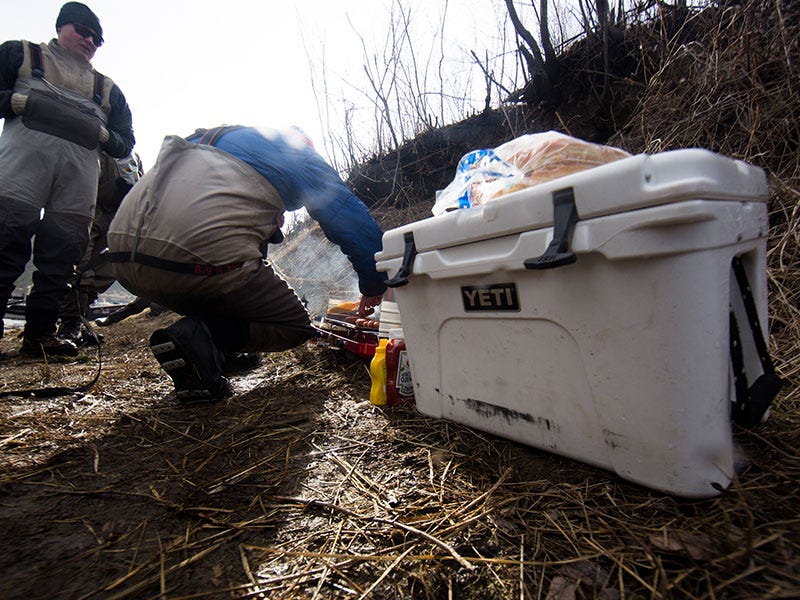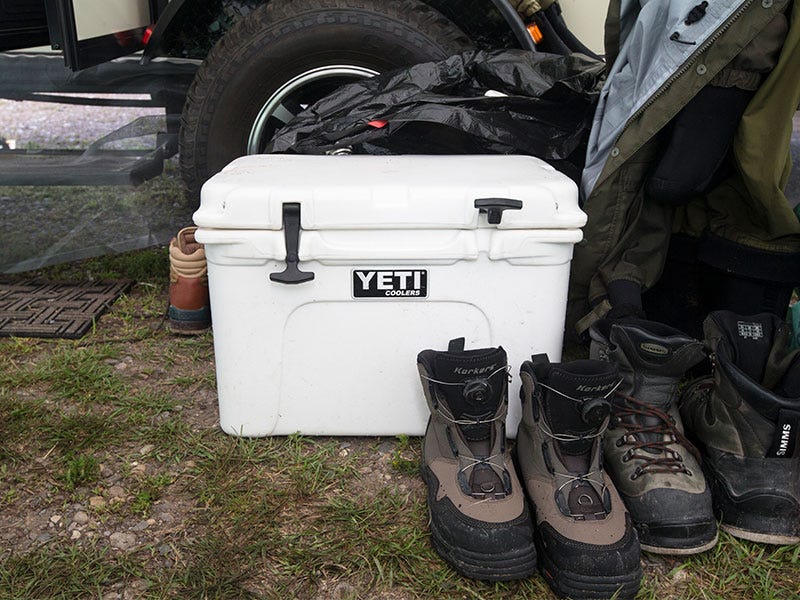Why are YETI coolers so expensive? (Spoiler: There's a bear in here)

Who is the YETI cooler NOT for? Me.
Full disclosure: I don't own a Yeti cooler, probably for the same reason a lot of people don't... the price tag.
But check out their marketing (the video below)--it's incredible, and I watch all of their new short film releases regularly.
So why don't I own a Yeti?
Yeti coolers are designed for serious outdoor enthusiasts, guides, backpacking families and just all-around outdoors people... and while I'd like to consider myself "a serious Montana outdoors-man," the truth is--I have two kids, one is just turning 6 and one is recently 3.

Our "outdoor trips" consist of single day outings to accessible, fishy water where my kids can wear their life jackets, throw some flies around... and I can sneak down river a few hundred yards and try desperately to catch fish before my youngest comes and throws tiny, fist-sized boulders into the water.
So for me, a $4 Styrofoam cooler with a lockable lid that won't tip over in the trunk of my Honda Civic works perfectly to keep the juice boxes cool, the cheese sticks and peanut butter and jelly at an edible temperature and my single IPA cold enough for the 6 hours I am "out" in the Montana "wildlands."
(That 6 hours is an "AT MOST" time... and does not consider when someone falls in the water, when someone smashes a hand or gets cut on a log, when there's a bee sting, when...etc, etc.)
At North 40, we actually stock the Yeti Hopper which is probably a better option than a Styrofoam cooler, both environmentally and just in general... we also have a sub-$60 option here that would last me probably until about when my kids get to high school--that will be on my to-do list.
So if that ^ sounds like you... then your assessment of the Yeti cooler being outside your price range is probably right.
So when does spending over $300 on a cooler make sense?
Why is the Yeti line so expensive, and are they worth the money?
Here's a pro-tip: if there is a slight possibility that bears will try to raid your stash, then you'd probably best be served by purchasing a Yeti.
If you're out camping or hiking where bear encounters are a serious consideration in your plans, then you might need a Yeti... why?
Because bears are out in remote areas (mostly), and in some areas, bear-proof coolers are necessitated by law. In the case of the latter, places like Lolo National Forest in Montana require that all food containers be bear proof OR suspended "10 feet above the ground and 4 feet from the tree or pole used for suspension."
So, if you are heading somewhere like this in your outdoor future, then you will need to invest in a Yeti or another cooler approved by the National Forest you plan on visiting.
If you are going to be camping out for extended periods (even 2-3 days) then this is when the design of the cooler and the technology incorporated in that design start to make monetary sense.
If you are out on average even 2/3 days at a time without returning home; if you are a guide (definitely) that needs to provide meals for clients; if you like to eat meals that aren't from a packet (like these); if you spend at least one weekend out in the real wilds camping or fishing... then a YETI may be right for you.
AKA--if you are a serious outdoors person who needs serious equipment to make that time outdoors more enjoyable or successful, then investing in the right equipment makes sense.
Check out our selection of Yeti coolers and accessories online here.
Yeti Construction: Rotomolded Coolers Cost more to Make
So what makes the Yeti line so costly? They came out with a new way to make coolers stronger, and better... since then, they have remained at the top of the industry and Yeti continues to innovate.
For instance, rotational molding. Ryan and Roy Seiders were some of the first entrepreneurs in the world to build their coolers with this process. What's the process? It's a shell formed from a single piece--means coolers built with this process are way stronger.
Some more features that actually increase cost of production and therefore value? a brief list is below.
Here's a few features of the Yeti cooler:
- One-piece rotomolded polyethylene body
- Walls filled with thick 2" polyurethane insulating foam
- Lid filled with 3" polyurethane insulating foam
- Heavy duty, non-breakable, single hinge system
- Food-grade material construction you can even opt to use dry ice
- Non-slip rubber feet
- Lockable lid design with integrated padlock ports (locks are required in bear country)
- Built-in slots for the tie-down capability, making locking down a cooler to a deck or boat easier
That's a lot of tech, a lot of tooling and it all goes to produce an industry leading product. When does it make sense to pay more for a rotomolded cooler? Let's get to the warranty.
Yeti Warranty: Why that initial savings gets even better...
There is a 5 year warranty on some of the more popular brands, and a 3 year warranty on the new, YETI Hopper. You can read Yeti's full warranty and returns information here.
And if it doesn't last that long, then get a hold of YETI--they are dedicated to securing their spot as the manufacturers of "the most durable coolers and drinkware on the planet."
Spoiler alert: We sell Yeti's and other outdoor gear online, right here.
There is a certain drawback to being the clear leader in the cooler world... and that is apparent if you cruise any of the forums out there--people want to dethrone Yeti.
Everyone tries to dethrone a leader because we are humans, and sometimes we root for the underdogs--but the truth is, Yeti built a superior product and made it available to the market first... and they've only gotten better with time. They are even migrating production into the United States. They keep bringing new products to market and they are very good at what they do.
So, say you do cruise the forums before you go to buy a Yeti, below you will find one of the recurring topics people bring up about Yeti coolers (and rotomolded coolers in gerneral).
Precooling a Yeti before you Pack
Following on from the construction method of the Yeti, the rotomolded design, the same design used in other high-end cooler models like Pelican Coolers, can negatively impact the ice-retention of your cooler.
What?? Wait, wait read on.
Because there are ~2 inches of insulation in the sides of the Yeti cooler, and about 3 inches in the lid- it prevents heat transfer from the outside in that INCLUDES trapping heat inside the cooler.
So, if you leave your Yeti in the garage and it is 70 degrees out there, inside that Yeti, it will be about 70 degrees. Putting your ice directly in at that temperature will result in a LOT of ice melt to bring the temperature of the Yeti down from the homeostatic temp it has from the garage.
While this "problem," is an indication of the success of rotomolded coolers, it also means that you need to "precool" your Yeti before you pack for the trip. What's that entail? Just throw a bag of ice in the cooler the night before your trip, take it out in the morning and add the ice you need. You will reduce initial ice-melt and insure your supplies stay cooler, longer.
There will always be people out there trying to undermine an industry leader, and that is to be understood--but from our experience in the office, these coolers are well worth the money.
Still have questions about whether or not the Yeti line is right for you? Use the form below and we can help you make an informed decision on picking the right size/cooler based on your individual needs.

